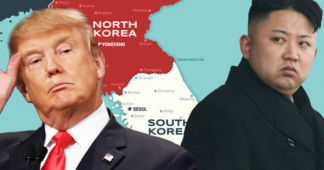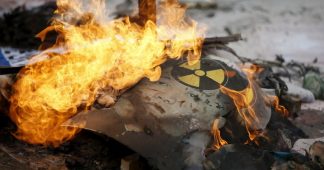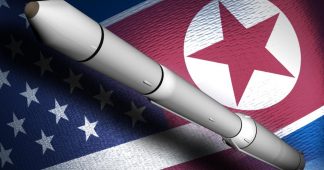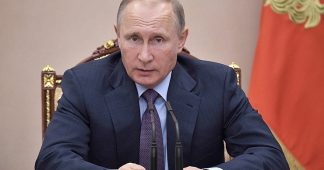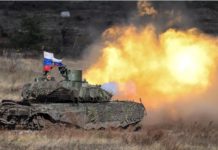By Omar Lamrani
5/10/2017
Since the turn of the millennium, war between nuclear powers has never loomed so near. As North Korea sprints toward the finish line in its race to build a credible nuclear deterrent, the window of opportunity to stop it is shrinking. With time running out, the United States may yet launch a preventive strike against Pyongyang’s nuclear and missile programs, convinced that military intervention is the only way to halt its smaller adversary in its tracks.
Within this narrow time frame, the risk of conflict on the Korean Peninsula will spike as the United States weighs the costs and benefits of attacking a country whose arsenal is already formidable. But should Washington opt against a preventive strike, or put off the decision for too long, the few options before it will be reduced to one: deterrence.
Armed and Dangerous
On paper, deterrence is a fairly straightforward concept: One country uses the threat of retaliation to stave off the attacks of another. But in practice, deterrence can look quite different depending on the nations implementing and being targeted by it. The circumstances that gave rise to the very concept of nuclear deterrence — the United States’ Cold War-era showdown with the Soviet Union — are radically different than those Washington now faces as its standoff with Pyongyang grows tenser by the day. And in many ways, deterring North Korea would be far trickier than deterring the Soviet Union ever was.
The most pressing danger the United States would have to worry about is miscalculation. Though North Korea’s development of a fully functional nuclear weapon and delivery arsenal would take the option of a preventive strike off the table, it wouldn’t preclude a pre-emptive strike aimed at stopping an imminent attack. In fact, because North Korea would have the ability to inflict catastrophic damage in a single go, the United States, South Korea and Japan would have even more reason to try to detect and block an attack by Pyongyang before it happens.
South Korea has already taken steps to improve its response time. Under its “proactive deterrence” strategy, Seoul has compressed its military chain of command to speed up decision-making, while with the still-developing Kill Chain program it aims to be able to detect and pre-empt any North Korean missile launch before it occurs. These programs are only a small part of the broader strategies that the United States, South Korea and Japan will put in place against North Korea. But the ability to act faster comes with its own dangers as well. Under pressure to issue a quick and overwhelming response ahead of a seemingly imminent nuclear attack — or, from Pyongyang’s perspective, a strike meant to decapitate the government of Kim Jong Un — parties on each side could easily trigger a devastating conflict on the basis of false intelligence or a simple misunderstanding.
A Race With No Winners
At the same time, the current strategic balance among the world’s biggest nuclear powers would begin to break down. The United States would inevitably ramp up its ballistic missile defense development, which would spur other nations to respond, perhaps in kind, or by adjusting nuclear posture or abandoning arms agreements. Already, the United States has a foundation of operational missile defenses to build on, ranging from regionally focused systems, such as the Terminal High Altitude Area Defense (THAAD), to strategic systems with the ability to shoot down intercontinental ballistic missiles, such as the U.S. Ground-Based Midcourse Defense.
This gradual buildup of U.S. missile defenses will meet vehement opposition from China and Russia. After all, a reliable anti-ballistic missile network could rob Beijing and Moscow of their own strategic deterrents, enabling Washington to launch a devastating first strike before intercepting and destroying any Chinese or Russian missiles that survive for use in a retaliatory strike. It came as no surprise when China pushed back against the recent deployment of the THAAD system to South Korea, or when Russia did the same in response to the United States’ plans to bolster Europe’s missile defenses. Any U.S. strategy of deterrence against North Korea that centers on missile defense would thus have wider global consequences, creating fertile ground for renewed rivalries and weakening the arms control regimes already in place.
All for One, and One for All
North Korea’s newfound capabilities would also raise questions among the United States’ allies about the reliability of extended deterrence. Under this policy, the United States has tried to ward off attacks against South Korea and Japan by vowing to come to their defense, regardless of whether North Korea could target U.S. cities with nuclear weapons. But would the United States truly be willing to risk Los Angeles to save Tokyo or Seoul? As Washington’s partners ask themselves this question, the prospect of “decoupling” — the breakdown of an extended deterrence umbrella as once-protected partners hedge their bets by seeking out their own defenses — will become all the more likely.
Of course, the United States could ease their fears somewhat by deploying tactical nuclear weapons to the region (most likely to South Korea). U.S. Secretary of Defense James Mattis recently discussed this possibility with South Korean Defense Minister Song Young Moo amid polls that showed nearly 70 percent of South Koreans support the move. If the talks result in action, it would place U.S. nuclear weapons directly in the line of fire, reducing the need for Seoul or Tokyo to create their own nuclear deterrents. It would also fortify the United States’ extended deterrence policy by giving Washington and its allies more options: Rather than having to resort to strategic nuclear weapons, they could respond to North Korean chemical or nuclear attacks on the battlefield with the less drastic option of tactical nuclear weapons — at least, in theory. The actual fallout of introducing tactical nuclear weapons to the Korean Peninsula would likely be much messier, dimming any prospect of someday denuclearizing the region while ratcheting up the risk of a wider nuclear war.
The United States has tried to reassure its Asian allies in more conventional ways as well. Washington recently agreed to lift the traditional payload limit in place on South Korean ballistic missiles, and it offered to sell both partners more advanced military equipment. But even as these moves shore up the United States’ alliances in Northeast Asia, they will reduce Washington’s ability to dictate the pace and outcome of events in the region, as South Korea and Japan expand their capabilities. And if either country, more emboldened and more powerful than ever, initiates its own offensive against North Korea, it could drag the United States into a war that was not of its choosing.
Perils Proliferate
A policy of deterrence against North Korea would carry new concerns for proliferation, too. Not only could South Korea and Japan seek out their own nuclear weapons, but North Korea would also set a troubling precedent for other nations: So far it is the only country to have joined the Non-Proliferation Treaty before subsequently withdrawing to pursue nuclear weapons. Moreover, there is a chance that North Korean nuclear and ballistic missile technology could spread to other countries. Though Pyongyang wouldn’t be eager to undermine its deterrent by selling nuclear weapons technology, it’s possibile that the cash-strapped and isolated government would sell missile development technology to longtime partners such as Iran.
While the precarious world of deterrence is certainly preferable to nuclear war, it comes with its own problems and perils. And given the particularly high level of mistrust and risk of miscalculation on both sides of the dispute over North Korea’s nuclear program, the next era of nuclear deterrence may well be the most dangerous the world has witnessed yet.
* Omar Lamrani focuses on air power, naval strategy, technology, logistics and military doctrine for a number of regions, including the Middle East and Asia. He studied international relations at Clark University and holds a master’s degree from the Diplomatic Academy of Vienna, where his thesis centered on Chinese military doctrine and the balance of power in the Western Pacific.
Published by Stratfor Worldview
